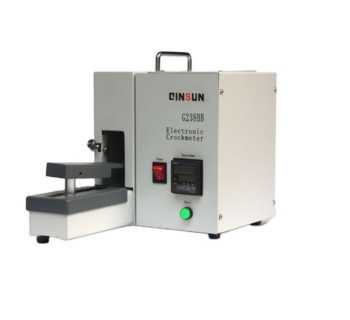Operation steps and application fields of electric rubbing color fastness tester

The electric friction color fastness tester is an instrument used to detect whether the color of textiles, leather, paper, and other materials will change during the friction process. The equipment is mainly used to evaluate the color fastness of the material, that is, the stability and durability of the color during use, especially in the friction environment, whether the color will fade or migrate due to the effect of friction.
The friction color fastness test is an important part of the quality inspection of textiles and other products. It is usually used to determine the color change caused by friction during normal wear or use of the fabric, especially the transfer of color to other surfaces. This test is crucial for a variety of products such as clothing, household goods, car seats, sports equipment, toys, paper, etc., because it is directly related to the visual experience of consumers after use and the product's durability.
The principle of the electric friction color fastness tester is to simulate the situation where an object is rubbed in daily use. During the test, the sample is rubbed with a certain type of friction material (such as clean white cloth, leather, etc.), and the friction force is usually achieved by an electric drive device. By setting a certain number of friction times and pressure, the instrument simulates the friction process when the fabric comes into contact with the skin, clothing, and other items, and evaluates the color fastness by measuring the degree of color change after friction.
Standards:
GB/T3920, GB/T5712, AATCC8, AATCC116, ISO105, JIS L0849, etc.

Operation steps:
1. Prepare samples: Cut the samples to be tested into standard sizes, usually 10cmx4cm rectangular samples.
2. Install friction materials: Select suitable friction materials (such as white cloth) and install them on the friction head to ensure that the surface of the friction material is flat and free of stains.
3. Adjust test parameters: Adjust friction pressure, speed, times, and other parameters according to actual needs. Different test conditions may need to be set according to different test requirements (such as international standards, industry requirements, etc.).
4. Conduct the test: Start the color fastness tester, the instrument starts working, and simulates the friction process between the sample and the friction material. During the friction process, the friction head will contact and rub the sample surface in a set manner to test whether the color of the sample will change.
5. Record results: After the test, check whether there is color transfer or fading on the surface of the sample, use standard color difference instruments (such as colorimeter) for quantitative detection, and record the specific data of color fastness.
6. Analysis and evaluation: According to the test data, combined with the color fastness evaluation standard, data analysis is carried out to evaluate the rubbing color fastness level of the sample. Commonly used evaluation standards include ISO105-X12, AATCC8, and other international and industry standards.
Application fields of electric rubbing color fastness tester:
1. Textile industry: It is most widely used in the textile industry, especially in the production of clothing, household goods, bedding, and other fields. Its main function is to ensure the color stability of the product during normal use.
2. Leather products: Leather, footwear, luggage and other products also need to be tested for rubbing color fastness to ensure that there will be no fading or color migration during wearing.
3. Paper and printed materials: For printed materials, wrapping paper, labels, etc., the rubbing color fastness test helps to evaluate their printing quality and ensure that the printed color will not fall off or fade due to friction.
4. Automotive industry: Car seats, interior decoration, etc. also need to be tested for rubbing color fastness to ensure that the surface color of the seat will not change during long-term use.
5. Toys and stationery: For children's toys, stationery, and other products, rubbing color fastness testing helps to ensure that no harmful substances will migrate during the use of the product.
2025-02-10 11:15

